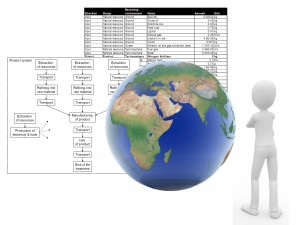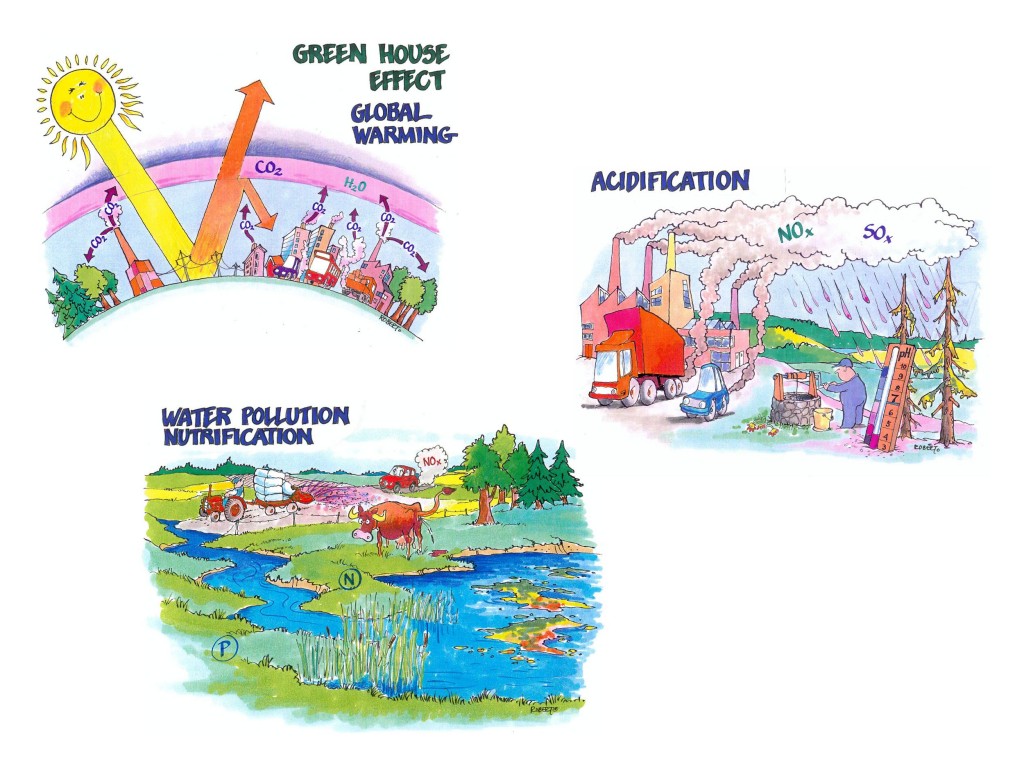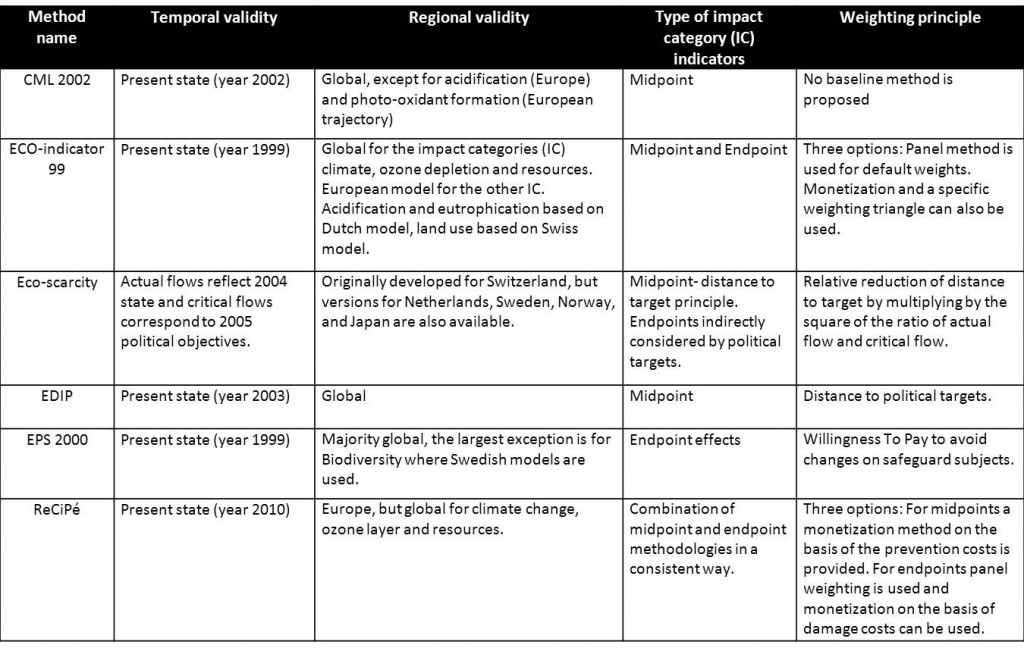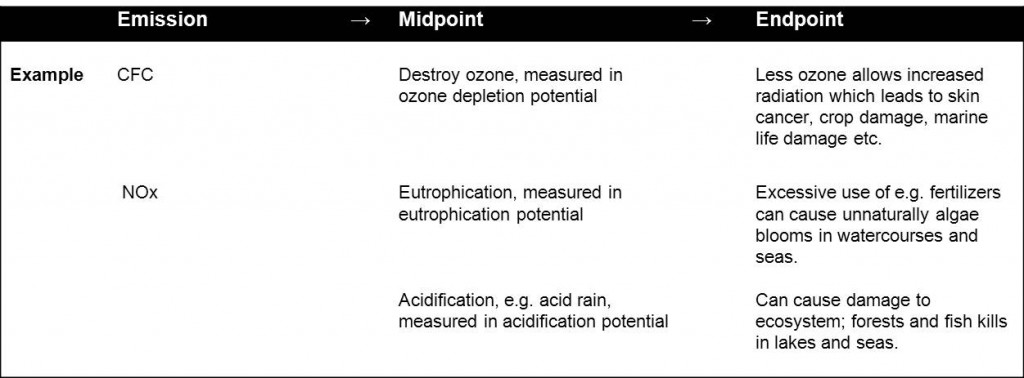Performing the environmental impact assessment in the LCA
By Ann-Christin Pålsson & Jenny Mattsson
Life cycle Impact Assessment (LCIA) aims to evaluate the potential environmental impacts of the product system. The impact assessment is made based on the inventory results and involves assessing the environmental consequences of the physical flows of inputs and outputs for the product system. For example, what are the environmental consequence of extracting a specific natural resource or emitting a specific substance to air or water?
 According to ISO14040 the impact assessment is divided into the following mandatory and optional elements:
According to ISO14040 the impact assessment is divided into the following mandatory and optional elements:
- Mandatory elements:
- Selection of impact categories, category indicators and characterization models, i.e. determine which types of environmental impacts to include and how they should be quantified through category indicators and characterization models.
- Classification – Assignment of inventory results to the selected impact categories, i.e. the individual inputs and outputs in the inventory is classified according to type of environmental impact.
- Characterization – Calculation of category indicator results, i.e. the result from the inventory is converted into the result for the selected category indicators.
- Optional elements:
- Normalization – Calculate the magnitude of category indicator results relative to reference information, e.g. the result for a new product is compared with the result for a reference product or with other reference information such as global or regional averages.
- Grouping – The impact categories are sorted and grouped according to e.g. geographic relevance, company priorities or ranking etc. to facilitate interpretation of results
- Weighting – Indicator results for different impact categories are converted to a common unit by using factors based on value-choices, i.e. the consequences for the different environmental impacts are prioritiesed and weighted against each other .
- Data quality analysis, i.e. assess the quality of the results from the impact assessment by identifying significant contributors and major uncertainty and sensitivity.
Impact assessment in practice
In practice, the impact assessment in LCA is usually performed using a ready made impact assessment method, where most of the choices in the impact assessment are implied, i.e. the selection of impact categories and category indicators, and where classification and models for characterisation and weighting have been developed.
There are different impact assessment methods available, where some only includes the mandatory elements and where some also includes the optional element weighting. Examples of available methods are presented in the table below. In the table the validity of the method is indicated in terms of time and geographical scope. Also, the type of impact category selected in the method is shown, as well as the principle used for the weighting.
Type of impact category – Midpoint vs. Endpoint
Usually there are two different types of practice that are followed in LCIA; midpoint (problem-oriented) and endpoint (damage-oriented). The midpoint approach is foremost based on internationally and scientifically accepted approaches, where flows are classified into different categories to which they contribute. These categories aim to simplify the evaluation of hundreds of flows into a few environmental areas that are of interest for the study. In the endpoint approach are also the flows classified into several environmental categories, but each category is modeled one step further, usually according to human health, ecosystem health, or damage to resources. For example see the table below.
Mandatory elements in impact assessment
Selection of impact categories, category indicators and characterization models
This step of the impact assessment is in practice made by selecting which impact assessment method to use. This since available impact assessment methods include a predefined selection and set-up of impact categories, category indicators and characterisation models. Therefore one should evaluate the method to make sure that the choices made in the method meets the needs of the study.
Impact categories are types or classes of environmental impacts, for example, Global Warming, Ozone Depletion, Photo oxidant Formation, Acidification and Nutrification (or Eutrophication). Depending on the impact assessment method, these categories can for example be referred to as safeguard subjects or areas of protection.

There are a couple of important aspects to consider when deciding which impact categories to use (based on ISO 14044 and Nordic Guidelines for LCA (1995)).
- Completeness: aims that the impact categories should cover as much as possible of interest for the study according to the goal and scope. In other words, the study should cover both major environmental problem as well as those of specific interest.
- Independence: the impacts categories used should be independent to avoid double counting.
- Practicality: the choice of categories must be practically feasible and should not include too many different categories.
- Possibility to integrate: there should be the possibility of connecting result parameters to choose impact categories and characterization methods.
- Environmental relevance: the chosen indicators have to be environmentally relevant to the impact categories and safeguard subjects.
- Scientific method: the characterization methods should be based on scientific knowledge.
The Impact categories are connected to category indicators which measures the environmental impact from the connected category.
The characterization models describe and quantify the environmental consequences for a specific extracted or released substance that is presented by the category indicator, e.g. how specific emissions to air impact a specific category indicator. The characterization models results in characterization factors, where the characterization factor quantifies the contribution of a input or output flow on the category indicator.
For example, the impact category “Global warming” has the category indicator “infrared radiative forcing”, where the characterization model is developed by the International Panel on Climate Change (IPPC). The model describes how different gases, referred to as greenhouse gases, potentially contribute to climate change. The resulting characterisation factors is named “Global Warming Potential”, where the factor for e.g. emissions of methane to air is 25 kg CO2 equivalents/kg emission of methane, based in IPPC 2007.
Classification and characterization – Classifying and calculating environmental impact
In the classification, the input and output flows from the inventory are classified and grouped according to type of environmental impact, i.e. the impact categories.
In the characterization the input and output flows from the inventory are used to calculate the result for the category indicators. Emissions can be assigned to one or several impacts. For example, CO2 is assigned to global warming, and NOx is assigned to both acidification and eutrophication. The contribution (result) from each input and output in the product system are then aggregated into a total for each category indicator . In practice this calculation is performed by multiplying the LCI results with characterization factors.
For example, the category indicator Global warming potential is measured in CO2 equivalents. In this case the characterization involves:
1. Converting all emissions to air from the product system that contribute to global warming (CO2, methane, nitrous oxides, freons etc.) into CO2 equivalents, and;
2. Adding up the contribution from each emission into the total CO2 equivalents for the product system.
Optional elements in impact assessment
Normalization – to compare
The purpose of normalization is to get a better understanding of the results from the inventory and impact analysis, (which sometimes can be difficult to interpret since the results may vary in units and magnitudes). Moreover, it helps to analyze the relevance of individual contributions but also relates them to different parts of the process. This can be done by comparing the quantified impacts with a certain reference value. Example of reference value can be the average environmental impact of a Swedish citizen in one year.
Grouping – to create order
The purpose of grouping is to create a clearer overview of the environmental impact. During the grouping the characterization results are divided into different categories or groups according to the definition made in the goal and scope. The division step may include sorting or ranking. Sorting means that all emissions are divided into categories and then sorted on a nominal basis (input / output, global / local, etc.) or by ranking in a given hierarchy (high, medium, and low priority). It is very common, that studies based on the same indicator results, will give different ranking results since the ranking is based on value-choices.
Weighting- to prioritize
The purpose of weighting is to reach a single value that describes the total environmental impacts of the product system. This is done by weighting the impact categories on a value basis, and then present them in an overall summarized index. Usually the methods to create weighting factors are based on social science or other principles; see below for example.
Willingness To Pay (WTP) presents the value a person is willing to pay to avoid environmental damage. Usually panels, representing different interest groups, generate data on these values. This principle is used in the EPS method.
Authorized targets are based on a distance-to-target-thinking. Usually the targets are formulated by authorities or companies and consist of a comparison between current levels of pollution and targeted levels. This principle is ised in the EDIP metod. However, it has been questioned whether the use of authorized targets belong to weighting methods, because the targets are not weighed against each other as in other methods.
Panel weighting use some type of panel/group to create weighting factors. Eco-indicator 99 is a weighting method based on a Swiss LCA interest group, where members are asked about their view and attitude towards environmental damage.
It is important to keep in mind that weighting methods are uncertain since they only describe an answer based on the method’s assumptions and system boundaries. Therefore, weighting should only be used when it is necessary to make the inventory data more easily interpreted.
Data quality analysis
Data quality analysis is used to further understand and test the reliability and uncertainty of the LCIA results. Preferable steps according to ISO 14044 are uncertainty analysis, sensitivity analysis and contribution analysis.



